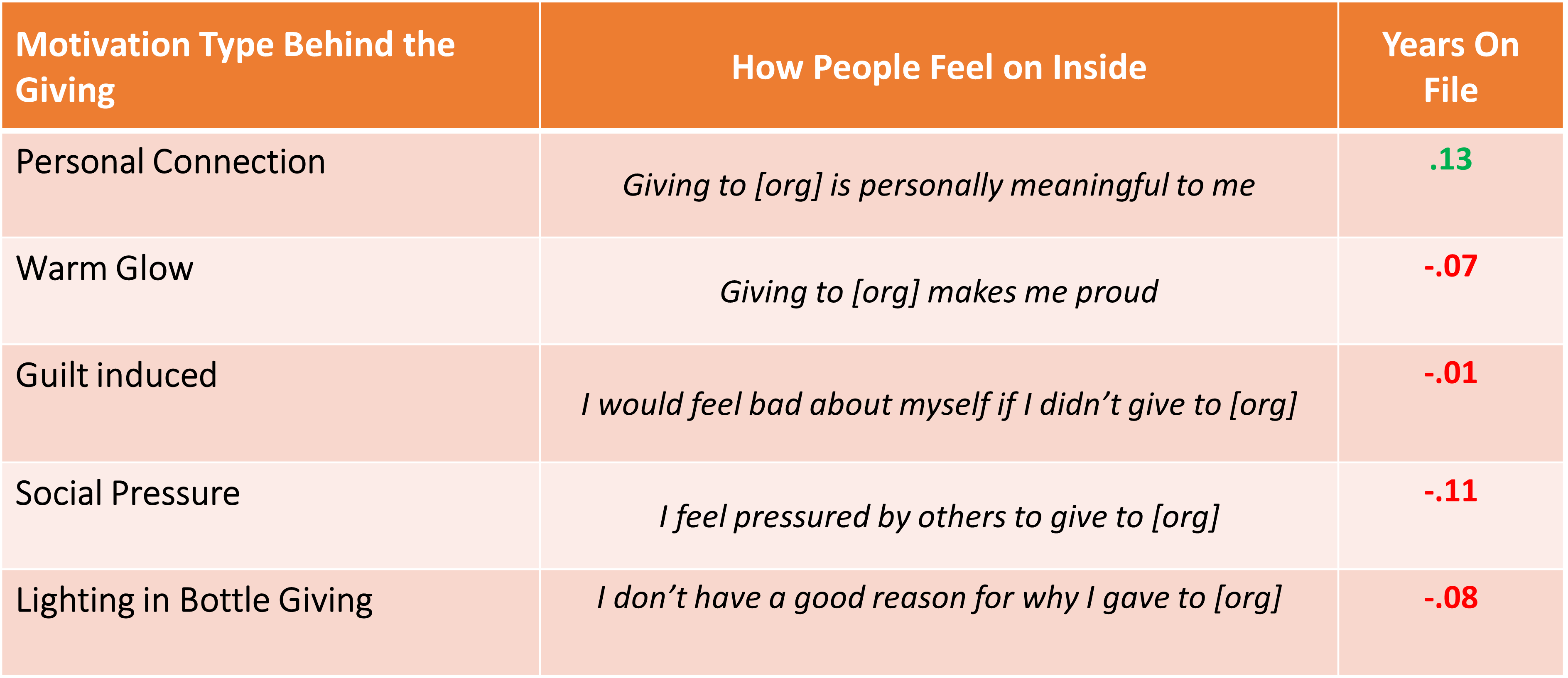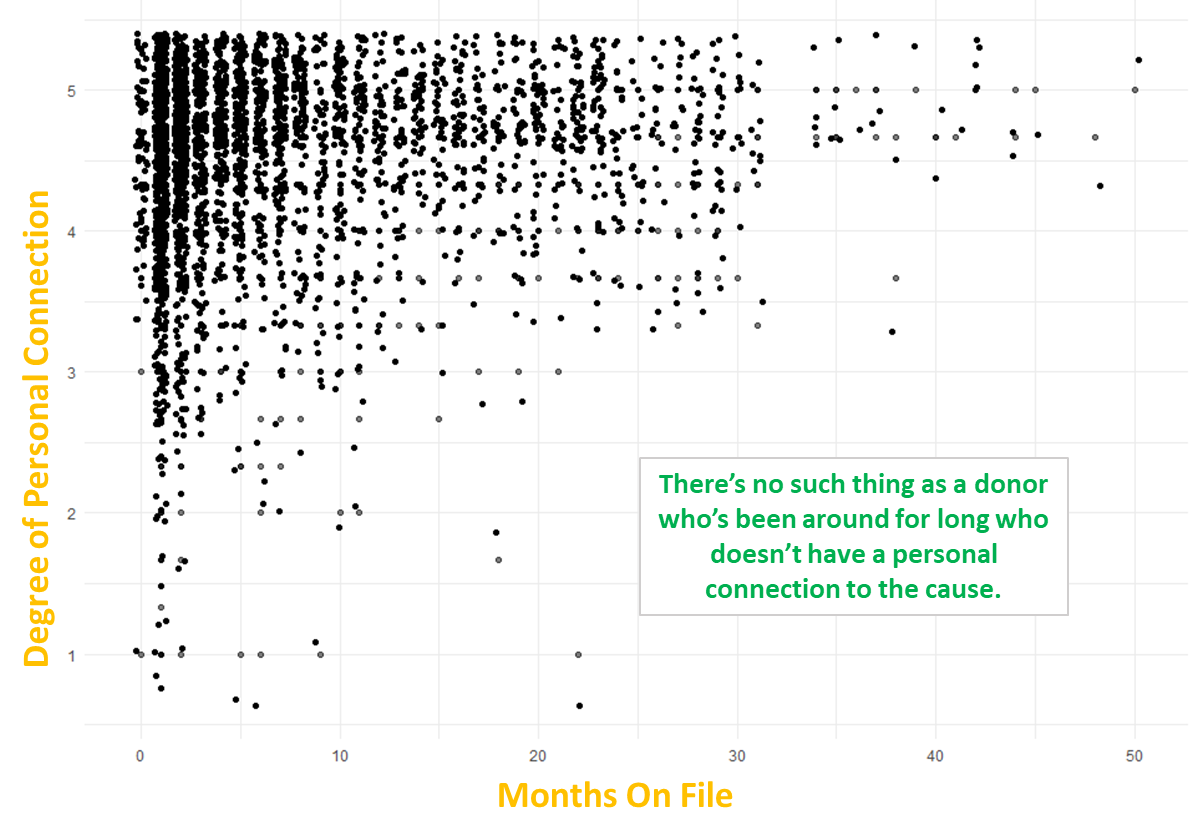Breaking Up with Warm Glow: Why Your Donors Deserve a Deeper Flame
People like to give because it fosters a warm glow. Therefore, more asking equals more opportunities for this warm glow. Ergo, donors are happy, satisfied, and fueled with positive motivation to keep giving contingent on you continually asking.
When I see this logic train cited it conjures up a record player’s arm lifted, the needle skidding across the vinyl’s grooved surface and a screeching sound clawing at the air.
Warm glow may be a real phenomenon but it’s not what creates long-term connection and therefore value. It’s too fleeting, ephemeral. And that’s with me setting aside the Grand Canyon sized assumption that your appeals are in fact, fostering warm glow potential vs. negative emotions.
Here’s proof. This is data from almost 4,000 donors across a wide cross section of charities. DonorVoice directly measured motivational quality and combined this data with CRM giving data.
There’s only one type of Motivation positively correlated with retention (i.e., years on active file). All the others are negative, including warm glow.

The vast majority of givers who keep giving do so for auto-biographical and personal reasons. This likely rings true to anyone who’s talked to a person about why a charity made it into their will.
There’s no such thing as a long-term donor without this innate, personal connection as evidenced by this plot showing nothing but white space in the lower right.

This chart does show some people making it to the upper right – high degree of personal connection and long tenure. But industry retention data and the large cluster of people in the upper left are highly suggestive of our leaving a lot of connection on the table.
This loss sits there like latent energy. The connection to mission is real. Making it easy for the person to see their values and goals in your interaction with them is the missing flame. Those sticking around long enough to traverse to the upper right are putting in a lot of mental energy, often in spite of the brand interaction, not because of it.
How to change this? For starters, Identity and Personality Fundraising. Their Identity is that part of them connected to your mission. The conservationist, the alumnus, the dog lover, the cancer survivor, the globalist, the activist… Their Personality is how you package the Identity message. Not all Conservationists are the same.
Knowing your donor’s Identity and Personality, whether you have 1,000 donors or 1,000,000, is doable, in days. Having and acting on this knowledge is not limited by organizational size.
Choosing to fundraise differently and not treat everyone the same is 100% mindset.
Your donors are different but predictably so. You can maximize their connection and your return by acting on it. Do or don’t, your call. But don’t, chose “don’t” with warm glow and business as usual as your fallback.
Kevin



Glad to see your research backs up what I think we’ve always known. Any kind of positive feeling, including gratitude, must be repeated to have a lasting value (there’s research on this too). If you meet someone once, you may have a pleasant interaction. But if you never follow up with them again, you’ll remain strangers. That’s why we don’t remain connected to every Tom, Dick and Mary who serves us in a restaurant. But if we return, they greet us by name, and even remember our favorite beverage, then a connection begins.
It’s the quality of the relationship, not the quantity of “moves.”
Hi Claire, yes, quality over quantity, a much-needed mantra on repeat and dialed to 11.
Very interesting, thanks. It’s a complicated change of mindset for many fundraisers to get away from segmentations that are not very useful for retention, based on demographic or transactional variables, and start investigating personal preferences. but it is a necessary change. difficult, because if you sell a product you have more tools than if you sell the impact of donations or the emotion of donating, but this is the path, that’s where we have to go. as you say, in the conservative segment (or in the generation Z) segment the motivations to keep on donating of individuals are so different, how can we continue to consider them as an homogeneous whole?
Hi Enrico, hope all is well. Yes, we often use what’s see-able (age, sex, race), automatically collected (donation behavior) or easy to append (e.g. income) and mistake it for useful. And good point that a product with features or benefits that is actively sought by the consumer can, potentially, more easily fill up the benefit bucket to offset cost (time, money, hassle). In our world, it’s typically only psychological benefit and while it is very doable to fill up the bucket that way, we tie one hand behind our back but not digging deeper on motivation and realizing it isn’t the same for everyone.
Kevin, Just trying to understand what you mean by “personal connection.” I’m reading your summary of your research that your use of personal connection means the donor’s connection with the cause/mission and not a statement about someone in the organization having a relationship with that donor. Or am I reading this incorrectly? And, did you test the relationship part?
Hi Gayle, you are correct, we’re defining Personal Connection as that connection between the donor and the mission. They support it becasue it aligns with a personal belief in the cause rather than external incentives like social recognition or tax deductions or interpersonal relationships (your example).
People who strongly agree that they “support Charity X because it reflects my personal values” are high in Personal Connection and much more likely to give and keep giving. It’s a strong, persistent flame if it burns internally for these reasons.
Having a personal relationship with someone at the charity needs to be qualified. If the donor’s primary motivation is to please or maintain a good relationship with the staff member, without a deeper personal endorsement of the charity’s mission, then that is lower quality, external motivation as they’re probably influenced by the desire for approval or to avoid disapproval. On the other hand, if the personal relationship helps the donor to recognize and agree with the importance of the charity’s work, leading to a conscious valuing of the donation as important in its own right, then the motivation aligns more closely with Personal Connection as we’re defining it.
We also measure the strength of the Relationship between the Donor and the brand (very different from the mission/cause). We know that what fosters a strong brand connection requires reliability/consistency (step 1), a sense of reciprocity and connection to the brand (step 2) and ultimately, a level of trust and commitment to the brand (step 3 of 3). If a donor has high Personal Connection and High Commitment (our short-hand label for Relationship Strength between donor and brand) then they are a donor for life.